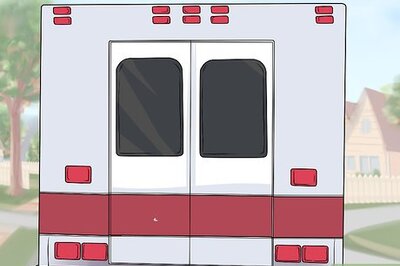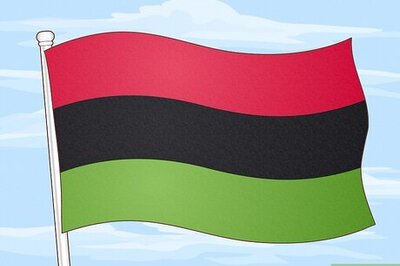
views
12 Common Types of Noses & Their Meanings
Fleshy nose A fleshy nose is characterized by a wideset base, large nostrils, and a prominent protruding tip. Some people associate fleshy noses with warm, outgoing people who are open and honest in their conversations and dealings with others.
Button nose A button nose is a small, round nose upturned just slightly at the bridge. Its diminutive shape compels many people to associate it with the innocence and sweetness of childhood.
Roman nose A Roman nose (also known as a Patrician or aquiline nose) is long with a slight curve descending from a prominent bridge on top. People with Roman noses may carry themselves with a noble, leader-like air. The nose shape's association with nobility and leadership is likely because many ancient Roman leaders – including Julius Caesar – have been depicted in statuary and other art with this type of nose.
Greek nose A Greek nose, which is also called a straight nose, features a long straight bridge and a pointed tip. This type is associated with the Greeks because it appears often in sculptures and carvings from that ancient culture. In addition, the nose shape's elegant yet minimalistic aesthetic aligns with the Greeks' distinctive architectural style.
Nubian nose A Nubian nose is characterized by a prominent bridge and a wideset base. It's most common in individuals with African ancestry and is associated with beauty, power, and confidence.
East Asian nose An East Asian nose is medium to large with a broad bridge and a flat appearance from the front. The nostril openings are also prominent in this nose shape. People with this nose shape typically have Chinese, Korean, or Japanese ancestry and may have down-to-earth, calm personalities.
Hawk nose A hawk nose is similar to a Roman nose – in fact, one is often confused with the other! But there are a couple of features that distinguish it from the aquiline shape. The first is a narrower nose bridge and the second is a pointy nose tip. Overall, a hawk nose looks more beaklike than a Roman nose. People who have hawk noses tend to have a high degree of confidence (sometimes bordering on arrogance) and lots of ambition.
Snub nose A snub nose is another example of a nose type that is often confused with another type – in this case, it tends to be interchanged with the button nose. While they look similar, a snub nose is rounder and stubbier. That doesn't make it any less cute, however, and people with snub noses often enhance that cuteness with their playful personalities.
Flat nose A flat nose is a nose with a generally flat appearance. Neither the bridge nor the tip are prominent; even the nostrils tend to be small in this nose shape. People who have flat noses may be more grounded in reality than others and place a high value on financial and personal stability.
Bumpy nose A bumpy nose has bumps on the sides. These usually result from past incidents when the nose was broken and never reset. A person with a bumpy nose is likely highly active and always open to taking on new challenges.
Bulbous nose A bulbous nose has a large, round or misshapen tip. The size of the tip makes the bulbous nose appear prominent on the face. It can develop naturally or as a result of a skin disorder called rhinophyma in which the nose becomes red and enlarged. Regardless of the reason, people with bulbous noses often embrace their nose shape and may be more cheerful and outgoing than others.
Turned-up nose A turned-up nose is a nose type with a straight bridge and a tip that angles upward. Because of the upturned shape of the tip, the nostril openings tend to appear more prominently on the sides than normal. The turned-up nose can sometimes be associated with snootiness and arrogance, but it can also lend a person a charmingly mischievous appearance (Iike a fairy or a sprite).
How Noses Get Their Shapes
Different nose types may have formed in different climates. One of the functions of the nose is to warm and moisturize the air it inhales. According to many scientific researchers, people who live in cold, dry climates need smaller nostrils to regulate the amount of air coming inside and give the nose enough time to do its job. Similarly, people who live primarily in warm, humid climates need larger noses with wider nostrils to take in more of the hospitable air. Therefore, if your nose is small, it's possible your ancestors came from an area of the world with frequent cold, dry weather. A person with a large nose may have ancestors who lived in a warm place with lots of humidity.
Noses can also change shape for health reasons or because of injuries. People who notice changes in their nose shape may also be experiencing underlying health conditions like rhinophyma or pregnancy. Injuries can also break or shatter the soft cartilage in the nose and cause it to become misshapen or swollen.
How to Change Your Nose Shape
Inject dermal fillers into your nose to change its shape non-surgically. If you want to change up you nose shape without surgery, dermal fillers are often a safe (if non-permanent) option. Dermal fillers are gel-like products that a dermatologist or a certified esthetician inject beneath your skin to add volume in specific areas. A little bit of dermal filler can lift up a flat nose or even out a misshapen bridge.
Undergo rhinoplasty to surgically alter or reconstruct your nose. Rhinoplasty, or nose surgery, can be a great option if you want to change the shape of your nose permanently. During this procedure, depending on the extent of the nose job, your surgeon may make incisions in your nose and pull the skin back so they can shift, remove, or rebuild parts of your nose. People who get rhinoplasty may do so because they simply don't like the shape of their nose. Others may have functional reasons behind the decision, like wanting to breathe better.

















Comments
0 comment